The ERF E14 32.ST was 35% worse than the Leyland
Page 41
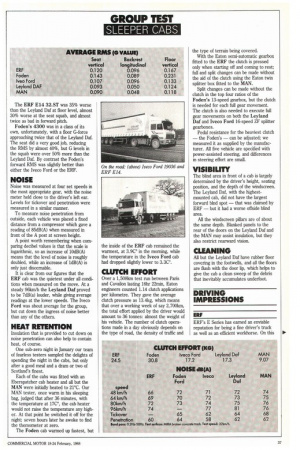
Page 42
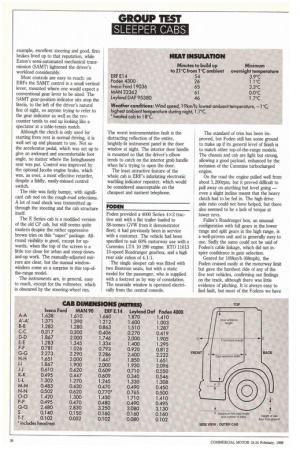
Page 43
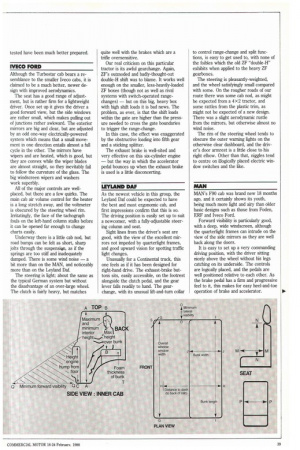
Page 44
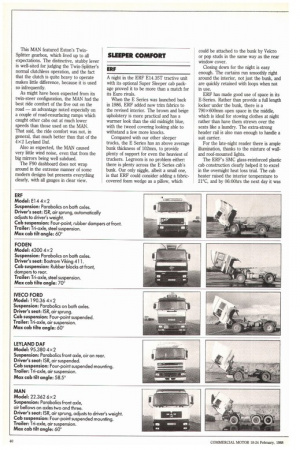
Page 45
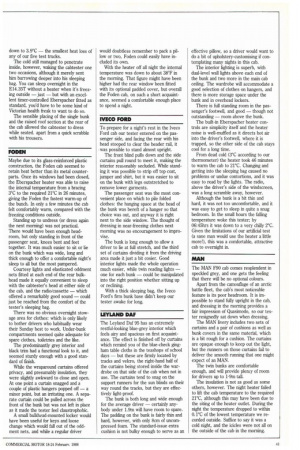
If you've noticed an error in this article please click here to report it so we can fix it.
Daf at floor level, almost 30% worse at the seat squab, and almost twice as bad in forward pitch.
Foden's 4300 was in a class of its own, unfortunately, with a floor G-force approaching twice that of the Leyland Daf. The seat did a very good job, reducing the RMS by almost 40%, but G levels in the squab were over 50% more than the Leyland Daf. By contrast the Foden's forward RMS was slightly better than either the Iveco Ford or the ERF.
Noise was measured at four set speeds in the most appropriate gear, with the noise meter held close to the driver's left ear. Levels for fickover and penetration were measured in a similar manner.
To measure noise penetration from outside, each vehicle was placed a fixed distance from a compressor which gave a reading of 85dB(A) when measured in front of the A post at screen height.
A point worth remembering when comparing decibel values is that the scale is logarithmic, so an increase of 10dB(A) means that the level of noise is roughly doubled, while an increase of ldB(A) is only just discernable.
It is clear from our figures that the ERF cab was the quietest under all conditions when measured on the move. At a steady 961cm/h the Leyland Daf proved to be 7dB(a) louder, while giving average readings at the lower speeds. The Iveco Ford was about average for the group, but cut down the ingress of noise better than any of the others.
Insulation that is provided to cut down on noise penetration can also help to contain heat, of course.
One sub-zero night in January our team of fearless testers sampled the delights of spending the night in the cabs, but only after a good meal and a dram or two of Scotland's finest.
Each of the cabs was fitted with an Eberspatcher cab heater and all but the MAN were initially heated to 21°C. Our MAN tester, once warm in his sleeping bag, judged that after 36 minutes, with the temperature at 17C°, the cab heater would not raise the temperature any higher. At that point he switched it off for the night; seven hours later he awoke to find the themometer at zero.
The Foden cab warmed up fastest, but the inside of the ERF cab remained the warmest, at 3.9C° in the morning, while the temperature in the Iveco Ford cab had dropped slightly lower to 3.3C°.
Over a 1,508km test run between Paris and Cavailon lasting lfitir 22min, Eaton engineers counted 1.14 clutch applications per kilometre. They gave the average dutch pressure as 13.4kg, which means that over a working week of say 2,7001cm, the total effort applied by the driver would amount to 36 tonnes: almost the weight of his vehicle. The number of dutch operations made in a day obviously depends on the type of road, the density of traffic and With the Eaton semi-automatic gearbox fitted to the ERF the clutch is pressed only when starting off and coming to rest; full and split changes can be made without the aid of the clutch using the Eaton twin splitter box fitted to the MAN.
Split changes can be made without the clutch in the top four ratios of the Foden's 13-speed gearbox, but the dutch is needed for each full gear movement. The clutch is also needed to execute full gear movements on both the Leyland Daf and Iveco Ford 16-speed ZF splitter gearboxes.
Pedal resistance for the heaviest clutch — the Foden's — can be adjusted; we measured it as supplied by the manufacturer. All five vehicle are specified with power-assisted steering, and differences in steering effort are small.
The blind area in front of a cab is largely determined by the driver's height, seating position, and the depth of the windscreen. The Leyland Daf, with the highestmounted cab, did not have the largest forward bind spot — that was claimed by ERF — but it had a worse offside blind area.
All the windscreen pillars are of about the same depth. Blanked panels to the rear of the doors on the Leyland Daf and the MAN may assist insulation, but they also restrict rearward vision.
All but the Leyland Daf have rubber floor covering in the footwells, and all the floors are flush with the door lip, which helps to give the cab a dean sweep of the debris that inevitably accumulates underfoot. example, excellent steering and good, firm brakes lived up to that reputation, while Eaton's semi-automated mechanical transmission (SAMT) lightened the driver's workload considerably.
Most controls are easy to reach: on ERFs the SAMT control is a small vertical lever, mounted where one would expect a conventional gear lever to be sited. The SAMT gear-position indicator sits atop the fascia, to the left of the driver's natural line of sight, so anyone trying to refer to the gear indicator as well as the revcounter tends to end up looking like a spectator at a table-tennis match.
Although the clutch is only used for starting from rest in normal driving, it is well set up and pleasant to use. Not so the accelerator pedal, which was set up to give an awkward and uncomfortable foot angle, no matter where the Isringhausen seat was put. Control was improved by the optional Jacobs engine brake, which was, as ever, a most effective retarder, despite a fiddly, easily-missed control switch.
The ride was farily bumpy, with significant cab nod on the rough-road selections. A lot of road shock was transmitted up through the steering and the cab structure itself.
The E Series cab is a modified version of the old CP cab, but still seems quite modern despite the rather oppressive brown trim on this "super" package. Allround visibility is good, except for upwards, when the top of the screen is a little too close for urban and steep downand-up work. The manually-adjusted mirrors are clear, but the manual windowwinders come as a surprise in this top-ofthe-range model.
The instruments are, in general, easy to reach, except for the voltmeter, which is obscured by the steering-wheel rim. The worst instrumentation fault is the distracting reflection of the entire, brightly-lit instrument panel in the door window at night. The interior door handle is mounted so that the driver's elbow tends to catch on the interior grab handle when he's trying to open the door.
The least attractive feature of the whole cab is ERF's infuriating electronic warbling indicator repeater, which would be considered unacceptable on the cheapest and nastiest telephone.
Foden provided a 4000 Series 4x2 tractive unit with a flat trailer loaded to 38-tonnes GVW from it demonstrator fleet; it had previously been in service with a customer. The vehicle had been specified to suit 60% motorway use with a Cummins LTA 10 290 engine. RTO 11613 13-speed Roadranger gearbox, and a high rear axle ration of 4.1:1.
The single sleeper cab was fitted with two Bostrom seats, but with a static model for the passenger, who is supplied with a footrest as by way of consolation. The nearside window is operated electrically from the central console. The standard of trim has been improved, but Foden still has some ground to make up if its general level of finish is to match other top-of-the-range models. The chassis and cab are light but strong, allowing a good payload, enhanced by the inclusion of the Cummins turbocharged engine.
On the road the engine pulled well from about 1,200rpm, but it proved difficult to pull away on anything but level going even a slight incline meant that the heavy clutch had to be fed in. The high drive axle ratio could not have helped, but there also seemed to be a lack of torque at lower revs.
Fuller's Roadranger box, an unusual configuration with full gears in the lower range and split gears in the high range, is a well-proven unit and is generally easy to use. Sadly the same could not be said of Foden's cable linkage, which did not inspire confidence in gate selection.
Geared for 109km/h (68mph), the Foden cruised easily at the motorway limit but gave the harshest ride of any of the five test vehicles, confirming our findings on the track, although there was little evidence of pitching. It is always easy to find fault, but most of the Fodens we have Although the Turbostar cab bears a resemblance to the smaller Iveco cabs, it is claimed to be a much better, newer design with improved aerodynamics.
The seat has a good range of adjustment, but is rather firm for a lightweight driver. Once set up it gives the driver a good forward view, but the side windows are rather small, which makes pulling out of junctions rather awkward. The exterior mirrors are big and clear, but are adjusted by an odd one-way electrically-powered system which means that a small movement in one direction entails almost a full cycle in the other. The mirrors have wipers and are heated, which is good, but they are convex while the wiper blades are almost straight, so they inevitably fail to follow the curvature of the glass. The big windscreen wipers and washers work superbly.
All of the major controls are wellplaced, but there are a few quirks. The main cab air volume control for the heater is a long stretch away, and the voltmeter is obscured by the steering wheel rim. Irritatingly, the face of the tachograph fouls on the left-hand column stalks before it can be opened far enough to change charts easily.
Underway there is a little cab nod, but road bumps can be felt as short, sharp jolts through the suspensign, as if the springs are too stiff and inadequately damped. There is some wind noise — a bit more than on the MAN, and noticeably more than on the Leyland Dat The steering is light; about the same as the typical German system but without the disadvantage of an over-large wheel. The clutch is fairly heavy, but matches quite well with the brakes which are a trifle oversensitive.
Our real criticism on this particular tractor is its awful gearchange. Again, ZF's outmoded and badly-thought-out double-H shift was to blame. It works well enough on the smaller, less-heavily-loaded ZF boxes (though not as well as rival systems with switch-operated rangechanges) — but on this big, heavy box with high shift loads it is bad news. The problem, as ever, is that the shift loads within the gate are higher than the pressure needed to cross the gate boundaries to trigger the range-change.
In this case, the effect was exaggerated by the obstructive loading into fifth gear and a sticking splitter.
The exhaust brake is well-sited and very effective on this six-cylinder engine — but the way in which the accelerator pedal bounces up when the exhaust brake is used is a little disconcerting.
As the newest vehicle in this group, the Leyland Daf could be expected to have the best and most ergonomic cab, and first impressions confirm that this is so. The driving position is easily set up to suit a newcomer, with a fully-adjustable steering column and seat.
Sight lines from the driver's seat are good, with the view of the excellent mirrors not impeded by quarterlight frames, and good upward vision for spotting traffic light changes.
Unusually for a Continental truck, this one feels as if it has been designed for right-hand drive. The exhaust-brake buttons sits, easily accessible, on the footrest alongside the clutch pedal, and the gear lever falls readily to hand. The gearchange, with its unusual lift-and-turn collar to control range-change and split functions, is easy to get used to, with none of the foibles which the old ZF "double-H" exhibits when applied to the heavy 2F gearboxes.
The steering is pleasantly-weighted, and the wheel satisfyingly small compared with some. On the rougher roads of our route there was some cab nod, as might be expected from a 4x2 tractor, and some rattles from the plastic trim, as might not be expected of a new design. There was a slight aerodynamic rustle from the mirrors, but otherwise almost no wind noise.
The rim of the steering wheel tends to obscure the outer warning lights on the otherwise clear dashboard, and the driver's door armrest is a little close to his right elbow. Other than that, niggles tend to centre on illogically placed electric window switches and the like.
MAN's F90 cab was brand new 18 months ago, and it certainly shows its youth, being much more light and airy than older basic designs such as those from Foden, ERF and Iveco Ford.
Forward visibility is particularly good, with a deep, wide windscreen, although the quarterlight frames can intrude on the view of the side mirrors as they are well back along the doors.
It is easy to set up a very commanding driving position, with the driver sitting nicely above the wheel without his legs catching on its underside. The controls are logically placed, and the pedals are well positioned relative to each other. As the brake pedal has a firm and progressive feel to it, this makes for easy heel-and-toe operation of brake and accelerator. This MAN featured Eaton's TwinSplitter gearbox, which lived up to all expectations. The distinctive, stubby lever is well-sited for judging the Twin-Splitter's normal clutchless operation, and the fact that the clutch is quite heavy to operate makes little difference, because it is used so infrequently.
As might have been expected from its twin-steer configuration, the MAN had the best ride comfort of the five out on the road — an advantage noted especially on a couple of road-resurfacing ramps which caught other cabs out at much lower speeds than those used on the MAN. That said, the ride comfort was not, in general, that much better than that of the 4x2 Leyland Daf.
Also as expected, the MAN caused very little wind noise, even that from the big mirrors being well subdued.
The F90 dashboard does not wrap around in the extreme manner of some modern designs but presents everything clearly, with all gauges in clear view. A night in the ERF E14.35T tractive unit with its optional Super Sleeper cab package proved it to be more than a match for its Euro rivals.
When the E Series was launched back in 1986, ERF added new trim fabrics to the revised interior. The brown and beige upholstery is more practical and has a warmer look than the old midnight blue, with the tweed covering looking able to withstand a few more knocks.
Compared with our other sleeper trucks, the E Series has an above average bunk thickness of 102mm, to provide plenty of support for even the heaviest of truckers. Legroom is no problem either: there is plenty across the E Series cab's bunk. Our only niggle, albeit a small one, is that ERF could consider adding a fabriccovered foam wedge as a pillow, which could be attached to the bunk by Velcro or pop studs in the same way as the rear window cover.
Closing down for the night is easy enough. The curtains run smoothly right around the interior, not just the bunk, and are quickly retained with loops when not in use.
ERF has made good use of space in its E-Series. Rather than provide a full length locker under the bunk, there is a 790 x600mm open space in the middle, which is ideal for stowing clothes at night rather than have them strewn over the seats like a laundry. The extra-strong header rail is also man enough to handle a suit carrier.
For the late-night reader there is ample illumination, thanks to the mixture of walland roof-mounted lights.
The ERF's SMC glass-reinforced plastic cab construction clearly helped it to excel in the overnight heat loss trial. The cab heater raised the interior temperature to 21°C, and by 06:00hrs the next day it was down to 3.9°C — the smallest heat loss of any of our five test trucks.
The cold still managed to penetrate inside, however, waking the cabtester one two occasions, although it merely sent him burrowing deeper into his sleeping bag. You can sleep overnight in the E14.35T without a heater when it's freezing outside — just — but with an excellent timer-controlled Eberspacher fitted as standard, you'd have to be some kind of Victorian health freak to want to do so.
The sensible placing of the single bunk and the raised roof section at the rear of the cab allowed the cabtester to dress while seated. apart from a quick scrabble with his trousers.
Maybe due to its glass-reinforced plastic construction, the Foden cab seemed to retain heat better than its metal counterparts. Once its windows had been closed, the Eberspacher heater was able to raise the internal temperature from a bracing 3°C to the required 21°C in 26 minutes, giving the Foden the fastest warm-up of the bunch. In only a few minutes the cab felt comfortably warm, compared with the freezing conditions outside.
Standing up to undress (or dress again the next morning) was not practical. There would have been enough headroom, but only standing in front of the passenger seat, knees bent and feet together. It was much easier to sit or lie on the bunk which was wide, long and thick enough to offer a comfortable night's sleep to all but the most pampered.
Courtesy lights and elasticated oddment nets fitted at each end of the rear bulkhead made it equally convenient to sleep with the cabtester's head at either side of the cab, and the radio/cassette — which offered a remarkably good sound — could just be reached from the comfort of the tester's sleeping bag.
There was no obvious overnight stowage area for clothes: which is only likely to bother drivers who habitually wear their Sunday best to work, Under-bunk compartments seemed quite adequate for spare clothes, toiletries and the like.
The predominantly grey interior and black trim had a functional look to it, and seemed sturdy enough with a good standard of finish.
While the wraparound curtains offered privacy, and presumably insulation, they were slightly awkward to close and open. At one point a curtain snagged and a couple of plastic hangers popped off — a minor point, but an irritating one. A separate curtain could be pulled across the front of the bunk but was not left in place as it made the tester feel claustrophobic.
A small bulkhead-mounted locker would have been useful for keys and loose change which would fall out of the oddment nets, and while a regular driver would doubtless remember to pack a pillow or two, Foden could easily have included its own.
With the heater off all night the internal temperature was down to about 38°F in the morning. That figure might have been higher had the rear window been fitted with its optional padded cover, but overall the Foden cab, on such a short acquaintance, seemed a comfortable enough place to spend a night.
To prepare for a night's rest in the Iveco Ford cab our tester entered on the passenger side, and facing the rear with his head stooped to clear the header rail, it was possible to stand almost upright.
The front blind pulls down and the side curtains pull round to meet it, making the interior reasonably secluded. While standing it was possible to strip off top coat, jumper and shirt, but it was easier to sit on the bunk with legs outstretched to remove lower garments.
The passenger seat was the most convenient place on which to pile folded clothes: the hanging space at the head of the bunk was bereft of a hanger so that choice was out, and anyway it is right next to the side window. The thought of dressing in near-freezing clothes next morning was no encouragement to improvise.
The bunk is long enough to allow a driver to lie at full stretch, and the third set of curtains dividing it from the driving area made it just a bit cosier. Good interior lights made the whole operation much easier, while twin reading lights — one for each bunk — could be manipulated into the right position whether sitting up or reclining.
With a thick sleeping bag, the Iveco Ford's firm bunk base didn't keep our tester awake for long.
The Leyland Daf 95 has an extremely restful-looking blue-grey interior which feels airy and spacious on first acquaintance. The effect is finished off by curtains which remind you of the blue-check gingham table cloths in the teashops of school days — but these are firmly located by tracks and velcro, the right-hand half of the curtains being stored inside the wardrobe on that side of the cab when not in use. The curtains tend to snag on the support runners for the sun blinds on their way round the tracks, but they are effectively light-proof.
The bunk is both long and wide enough for the average driver — certainly anybody under 1.9m will have room to spare. The padding on the bunk is fairly thin and hard, however, with only 8cm of uncompressed foam. The standard-issue extra cushion is not bulky enough to serve as an effective pillow, so a driver would want to do a bit of upholstery-customising if contemplating many nights in this cab.
The interior lighting is superb, with dual-level wall lights above each end of the bunk and two more in the main cab ceiling. The wardrobe will accommodate a good selection of clothes on hangers, and there is more storage space under the bunk and in overhead lockers.
There is full standing room in the passenger's footwell, and good — though not outstanding — room above the bunk.
The built-in Eberspacher heater controls are simplicity itself and the heater noise is well-muffled as it directs hot air into the driver's footwell, where it is trapped, so the other side of the cab stays cool for a long time.
From dead cold (3°C according to our thermometer) the heater took 46 minutes to warm the cab to 21°C. Changing and getting into the sleeping bag caused no problems or undue contortions, and it was easy to read by the lights. The radio, above the driver's side of the windscreen, was a long scramble away, however.
Although the bunk is a bit thin and hard, it was not too uncomfortable, and it was easy to get to sleep in quite a snug bedroom. In the small hours the falling temperature woke this tester; by 06:45hrs it was down to a very chilly 2°C. Given the limitations of our artificial test (a sane man would use the heater a little more!), this was a comfortable, attractive cab to overnight in.
The MAN F90 cab comes resplendent in speckled grey, and one gets the feeling that there will be no optional colours.
Apart from the camouflage of an arctic battle fleet, the cab's most noticeable feature is its poor headroom. It is impossible to stand fully upright in the cab, and dressing in the morning provides a fair impression of Quasimodo, so our tester resignedly sat down when dressing.
The MAN livery includes two sets of curtains and a pair of cushions as well as bunk covers in the same material, which is a bit rough for a cushion. The curtains are opaque enough to keep out the light, but the runners on those curtains fail to deliver the smooth running that one might expect of an MAN.
The twin bunks are comfortable enough, and will provide plency of room for drivers up to 1.9m tall.
The insulation is not as good as some others, however. The night heater failed to lift the cab temperature to the required 21°C, although this may have been due to the siting of the heater outlet. During the night the temperature dropped to within 0.1°C of the lowest temperature we recorded outside. Suffice to say it was a cold night, and the icicles were not all on the outside of the cab in the morning.
























































































